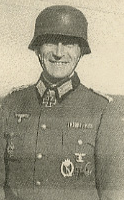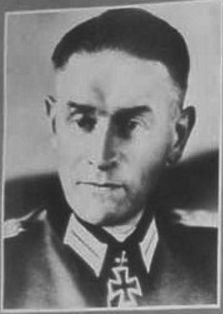Faulhaber, Karl (Grenadier-Regiment 282)
- Date of birth:
- January 11th, 1896 (Gerolzhofen/Unterfranken, Germany)
- Date of death:
- March 11th, 1972 (Munich/Bavaria, Germany)
- Nationality:
- German
Biography
Do you have more information about this person? Inform us!
- Period:
- Second World War (1939-1945)
- Rank:
- Oberstleutnant (Lieutenant-colonel)
- Unit:
- Kommandeur Infanterie-Regiment 282 - 98. ID
- Awarded on:
- November 12th, 1942
- Period:
- Second World War (1939-1945)
- Rank:
- Oberst (Colonel)
- Unit:
- Kommandeur Grenadier-Regiment 282 - 98. ID
- Awarded on:
- December 19th, 1943
“Just before daybreak on the 01.11.1943, and under the cover of numerous heavy batteries firing from the Taman peninsula, the enemy landed near Eltigen (south of Kertsch). At first the situation remained totally unclear. All means of communication were unavailable. Under the enemy’s artillery drumfire no battle noises could be heard except for a few scattered rifle and MG shots, which soon fell silent. Communications to the II./Grenadier-Regiment 282 (commanded by Hauptmann Dr. Finke, and in charge of coastal defense along with the local reserve) failed. Communications from Finke’s command post likewise failed to reach Hauptmann Vockentanz, commander of the I./Grenadier-Regiment 282 (which was on standby as the divisional reserve in Stary Karantin-Süd). Everything about the situation remained unclear, including the strength of the landed enemy, the extent of their beachhead and their current disposition.
Oberst Faulhaber, the commander of the coastal sector south of Kertsch, immediately resolved to personally carry out the necessary reconnaissance and restoration of communication with Hauptmann Finke. As he was driving forward he encountered the 2./Grenadier-Regiment 282 south of Kamysch-Burun. At the time this unit was taking cover from heavy enemy artillery fire in the road ditches. Heavy losses had been incurred, and the Kompanie commander had fallen out with severe injuries. At this same time Faulhaber perceived that the Russians were already marching westwards from Eltigen with about 200-300 men along the road Kamysch-Burun-Tobetschik. Russian elements were bypassing the firing position of the nearby 2./Artillerie-Regiment 198 on both sides. It therefore had to be assumed that the command post of Hauptmann Finke, located further to the south, had either been encircled or destroyed. If the enemy continued their advance further west they would capturing the commanding high ground south of Salt Lake. In doing so they would secure all the prerequisites for a further successful attack into the unprotected territory towards the west, and also enable further landings to take place in the particularly valuable Kamysch-Burun harbour.
Fully realizing the severity of the situation, and the need to take instant action, Oberst Faulhaber decided not to wait for the divisional reserve to arrive. He decided to launch an immediate attack with the already heavily weakened, leaderless Kompanie. Under heavy fire he got the Kompanie to get on its feet again, led them to a relatively safe place north of the road to reassemble, and then from here launched a flank attack into the enemy forces that were advancing northwards. Faulhaber himself led at the head of this attack. As the fully surprised enemy began to hesitate, Oberst Faulhaber managed to outflank the foremost enemy elements and push them back across the road. He subsequently captured a series of crests and quarries. During an immediately launched enemy counterthrust by strong enemy forces Oberst Faulhaber rushed from resistance nest to resistance nest, directing the individual soldiers to their targets and inspiring them through his personal example. In this way he ensured that, following back-and-forth combat, his troops were able to remain in control of the commanding strongpoints.
The successes that were achieved were of great and decisive importance for the continuation of combat in the area. The enemy’s strong landed forces were slowed down during their unopposed march to the west at the last second, and were forced to yield a considerable amount of their newly conquered territory. In the process they took significant losses and were thrown into confusion. The 2./Artillerie-Regiment 198 was freed from its imminent encirclement, and was once again able to deliver decisive artillery support for the forthcoming battles. Contact with Finke’s encircled command post and the forces that had been gathered to him was restored. Through this the conditions were created to form an unbroken line of resistance, from which an attack that sought to constrict the enemy beachhead would later be launched.
The success achieved under the personal, bold leadership of Oberst Faulhaber prevented the enemy breakthrough. It also laid the groundwork for newly brought up forces to significantly constrict the enemy forces in the Eltigen beachhead and form a defensive front that would be able to contain them with minimal amounts of friendly troops. This enabled the Kertsch peninsula to continue to be held with the weak available forces.”
- Period:
- First World War (1914-1918)
- Period:
- Second World War (1939-1945)
- Rank:
- Oberst (Colonel)
- Unit:
- Stab /Gren.Regiment 282
- Awarded on:
- February 9th, 1945
- Period:
- Second World War (1939-1945)
- Awarded on:
- April 29th, 1944
- Period:
- Second World War (1939-1945)
- Rank:
- Major
- Awarded on:
- June 29th, 1940
- Period:
- Second World War (1939-1945)
- Rank:
- Oberstleutnant (Lieutenant-colonel)
- Unit:
- Grenadier-Regiment 282
- Awarded on:
- November 5th, 1942
Silver version
- Period:
- Second World War (1939-1945)
- Rank:
- Major
- Awarded on:
- June 21st, 1940
- Period:
- First World War (1914-1918)
- Period:
- First World War (1914-1918)
- Period:
- First World War (1914-1918)
- Period:
- Second World War (1939-1945)
- Unit:
- Rgt.Stab/G.R.282
- Awarded on:
- November 10th, 1942
- Period:
- Second World War (1939-1945)
Sources
- Photo: TITLE
- - THOMAS, FRANZ & WEGMANN, GüNTER, Die Ritterkreuzträger der Deutschen Wehrmacht 1939-1945, Biblio Verlag, Bissendorf, 2003.
- Die Ordensträger der Deutschen Wehrmacht (CD), VMD-Verlag GmbH, Osnabrück, 2002
- Fellgiebel W.P., Elite of the Third Reich, The recipients of the Knight's Cross of the Iron Cross 1939-1945: A Reference, Helion & Company Limited, Solihull, 2003, ISBN 1-874622-46-9
- Patzwall K., Scherzer V., Das Deutsche Kreuz 1941-1945, Geschichte und Inhaber Band II, Verlag Klaus D. Patzwall, Norderstedt, 2001, ISBN 3-931533-45-X
- TITLE
















